|
|
Trip Report |
|---|---|
|
|
44.24437°N / 73.81318°W |
|
|
Nov 30, 2018 |
|
|
Mountaineering, Trad Climbing, Ice Climbing, Mixed |
|
|
Winter |
Introduction
With the exception of a few reports, my writings over the winter have been fairly short. Though I’ve uploaded photos and a couple paragraphs at times, I’ve been dedicating my time to a more intricate writing project. This seemed like a good time to compile the 2018-2019 ice climbing/winter hiking season. OPEN THE PHOTO GALLERIES IN EACH SECTION FOR A BETTER FEEL OF THE DAY. Use the NAVIGATION TO THE LEFT to avoid scrolling down.
My focus over the winter was multi-pronged. I wanted to get stronger after a bout of Lyme Disease in August (longer hikes helped with that), work on my “lead head” (harder roadside climbs were key), and wrap my head around some of the subjectively more difficult roadside routes that I’ve been ignoring over the recent years in lieu of the Panther Gorge pursuits. My strategy was partially to up my grade slightly, so I could comfortably climb harder backcountry lines in the future. My primary backcountry objective was a Panther Gorge line I’ve been trying to climb for a few years. Its position and finicky first pitch made it difficult to pluck, but persistence paid off and we finally put up Apex Predator.
The following is as much a journal for personal reflection as trip report, so enjoy and take it for what it’s worth. Partners in adventure this season included Ken Hebb, Scott van Laer, Loren Swears, Robbi Mecus, Bill Schneider, Matt Oakes, Ben Kurdt, Alan Wechsler, Aaron Courain, Don Mellor, Dan Plumley, Devin Farkas, Phil Brown, R.L. Stoltz, Karen Stoltz, Steve Thomas, Tom Dubois, Kennedy Quigg, Marielle Mathews, and Katie Vannicola.
Giant Mountain East Face with Ken Hebb - November 10, 2018
Photo album: https://photos.app.goo.gl/DckViVE39vebdZZ47
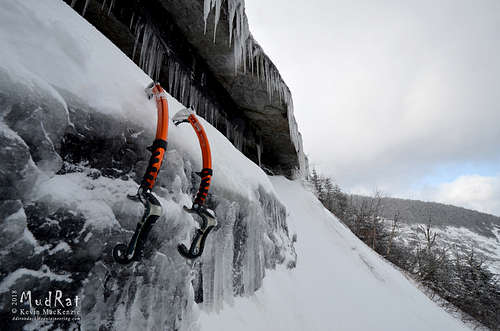
We broke through 18” of snow on November 10, 2018 as we hiked the Ridge Trail from Chapel Pond with rope, crampons, and a few screws in our packs (and a few loose ones in our heads). I knew the hunt for upper elevation ice might not yield stellar results, but it was a good training hike if nothing else. A man plodding through the deep powder and drifts led me to shake my head. He had quite the time on anything slippery and over 20 degrees in slope. The microspikes on the sneakers did little, nor did the jeans he wore. Thankfully, he was with a group of friends. I thought, This may be a big year for backcountry rescues.
We eventually reached the intersection with the trail to Rocky Peak Ridge. It was unbroken and, after some relaxation and food, we worked down toward the overlook where I often enter the slide. We found good snow and thin ice conditions on the slide, but the prime line where two faces adjoin was vapor thin and our pace dictated an early retreat so we didn’t walk over to the far side.
That didn’t mean we couldn’t explore for a short time, however! We diagonally descended toward the center of the slide. I soloed down a sketchy ledge for a better view of the entire face while Ken rappelled to my position. With an actual ice climb out of the question, our focus was on relaxing and enjoying the scenery.
The photo album tells the story more than words, but forming ice is a beautiful thing—the way it builds, colors, textures, etc. In all, this was a great start to get my backcountry legs in shape and dial in the gear.
Gothics North Face with Scott van Laer - November 24, 2018
Photo Album: https://photos.app.goo.gl/PTw1cdXJgg11uPuU8

Gothics North Face is like an old friend — engaging, fun, familiar, and even a bit moody. I look forward to visiting it annually, usually during mid-winter. Early-season climbing conditions involving thin ice and expanses of bare anorthosite generally set up in December or January, so a trip during November is a novelty.
I couldn’t think of a better way to celebrate the Thanksgiving weekend than by involving another old friend in my visit, Adirondack Forest Ranger Scott van Laer. Together we’ve explored several of the Adirondacks’ most dramatic backcountry slides: Marcy’s East Face, Saddleback’s Chicken Coop Slide, and Big Slide Mountain. While he’s certainly in it for the adventure, he also views each trip through the lens of a rescue professional. The more he knows about the approach and exit, features of the slide, types of available climbing protection, etc., the easier he can assess it if a rescue is needed.
Our trip began the night before when we spent the night at the Interior Outpost near Johns Brook Lodge. Scott walked in a couple of hours ahead of me to light a fire. I took my time and enjoyed the three-mile trek under a full moon — no headlamp needed. Its light cast long shadows through the blue-tinted forest.
The frigid weather during the preceding days ensured the log cabin was like an icebox, but a roaring fire in the wood stove created a small pocket of warmth. Scott’s a regular there, but it’s a treat for me to spend the night. Upon arrival, I found Scott wrapped in a blanket with his feet propped up near the burning logs. The soft glow of candles, a propane lamp, and the stove were all that illuminated the room. A hot bowl of soup topped off the evening, and a negative 15 degree-rated sleeping bag ensured a warm night’s sleep.
The Approach
DEC Interior Outpost
The alarm sounded at 5 a.m. It was tempting to remain curled-up in the sleeping bag near the stove and ignore our itinerary. We mustered the ambition to leave the cabin and were soon following snowshoe tracks up the Orebed Trail under the glow of headlamps. The trail was packed enough for comfortable walking, but the warm wind on my face foretold that it would soon soften.
I mentally sorted through the various conditions we might encounter during the approach and the climb. It was only November, so I imagined several grim possibilities, but the optimistic side of me vowed to make do with whatever we encountered as long as the objective hazards (there are always a few if you’re in the wilderness) were low. The face is only about 50 degrees in slope, so I can deal with ultra-thin ice or sections of bare stone, but a snow-loaded face ready to avalanche would end the day early.
The work began when we left the trail in two feet of unbroken snow. I usually walk up the stream to approach the base of the slide, but it was unfrozen, and swimming wasn’t part of the itinerary. Instead, we navigated through the woods and used the brook as a navigational rail, zigzagging our way through the evergreens before entering the drainage ½ mile upstream. Breaking trail through deep, untracked snow requires patience. I couldn’t rush it and have the energy to lead the climb. The bushwhack to the unobstructed view below the face took an hour and a half.
I’m always pensive when considering what line I should follow up the North Face. I generally seek a route that follows the most appealing sections of snow and ice even if the line meanders. The right-hand side, known as the New Finger Slide and left-hand side (which is slightly lower in angle) are often climbable when conditions are thin. The center usually takes the winter to set up nicely. In the end, current conditions always determine the best option, and I can rarely tell what looks safe until I’m standing at the base. Much of the face was bare, but a few minutes of study revealed several lines by which we could safely reach the summit. I chose one that started on the left and traversed toward the center.
I watched swirling spindrift dance across the lower face as I donned the crampons and flaked the rope. Stronger gusts rushed down the face at regular intervals. It was going to be spicy. Adapting to the weather is all part of the game; that’s why we bring a variety of layers.
Climbing the Face
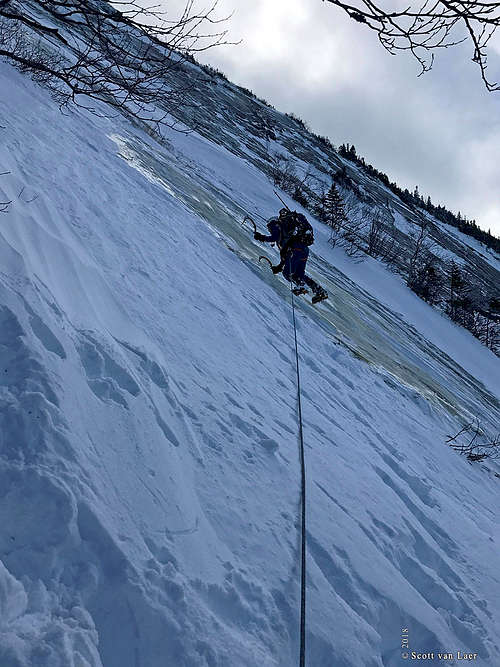
Once we were ready, Scott said, “On belay,” and I began climbing. The first pitch of 200 feet was up easy snow and ice to a stout tree where I set up an anchor and belayed him. Pitch two was a slog through shin-deep snow—hardly exciting, but it looked better up higher. I scouted the third pitch as I belayed. I vacillated between two options, one of which offered negligible protection. I’m accustomed to soloing the face (climbing without the protection of a rope), but I wanted to protect Scott from a solid anchor — not a ½ inch sapling. We opted for a line straight up a run of thin ice.
There was ice nearby, but ice screws were useless since the flows were too thin. A creative anchor in the turf was enough to keep him safe. Scott followed, his crampons scratching for purchase on the stone hidden under a thin layer of powder at the base of the ice flow. I kept the rope tight in case he slipped.
The following few sections were similar in character until we gained a large area of trees at the center of the face. The snow was neck-deep between the trees, so I traversed below them, belayed, and, when he was at the anchor, took a break to re-nourish.
An essential part of climbing is paying attention to one’s surroundings. This includes recognizing subtle clues that hint at weather changes. I felt the wind shift and looked west as we were eating. An ominous blanket of gray flowed like liquid over the western peaks that were visible only a few minutes before. A front was moving in.
The weather triggered a change in strategy as I knew rain was in the forecast for early evening. It was only early afternoon, but “mountain weather” doesn’t always follow the forecast. To save time and since we were now on a field of consolidated snow that offered secure climbing, I switched to a running belay. We both climbed at the same time (200’ apart), but I placed slings around small trees to protect us in case one of us slipped. Scott simply removed them as he passed by. I switched back to belaying from an anchor when the terrain got more challenging, and the ice and snow all but disappeared.
The wind increased as we climbed the last several pitches. The gusts were strong enough that I flattened my profile when I felt one coming. They weren’t as bad as during a January climb up the North Face several years ago, but they were substantial. I looked down the face as the sun dimmed. The forest below nearly disappeared from view. Vapors funneling up Gothics’ southern cirque swirled over the summit. We were climbing into the clouds while being pelted by blowing snow. Conditions such as these stir my blood. Bluebird days offer delightful climbing, but inclement weather adds an interesting dynamic if one is prepared. If you’re climbing the High Peaks during winter, you better be prepared!
We scaled the last pitch via a few sections of thin, brittle ice and bare anorthosite. It was steep, tedious work. The tailwind strengthened as I reached the krummholz on the ridge and bushwhacked to the trail. A cornice often forms in this area. It was in its infancy stages, but the snow was still nearly five feet deep. I found the trail and body-belayed Scott until he reached the security of the trees.
Exit

The time was 2:15 p.m. It had taken four hours to climb the face. We still had to walk to the summit and trek back down the steep Cable Route to the Orebed Trail. Hikers had broken the way, but the snow was soft and insecure underfoot. It was difficult to keep balance especially with the wind still blowing strongly. The summit ridge was a winter wonderland in November. The spruce trees were entombed. Their branches sagged and touched the surface of the snow. It will be interesting to see how the winter plays out at elevation.
There was no rush to get back to the cabin once we were in the Orebed Brook valley. Slow and steady was the best way to walk on the slushy trail at lower elevations. The headlamps came out as the sun set and our depth of field disappeared. It took roughly 13 hours from the time we left the cabin until I reached the trailhead — not a bad time given the snow depth.
Multiplication Gully (WI3+) with Loren Swears - December 1, 2018
Video: https://www.facebook.com/kevin.mudrat.mackenzie/videos/10213869183140843/
Photo Album: https://photos.app.goo.gl/q1yDvG1GT6uhyaLV8
Loren Swears and I took a run up Multi Gully before running over to Chapel Pond and doing laps on Rule of the Bone. Ice at the top of Multi was superb, but it was sketchy and delaminated in some spots for the first 120’. I love climbing this gully. Every climb is different, but the hanging daggers, delicate icicles, and ice formations never cease to amaze me - God's beautiful creations.
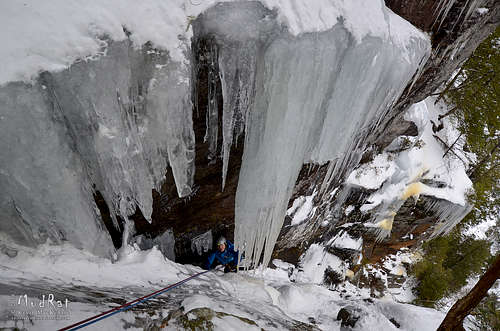
The Rime of Panther Gorge with Loren Swears - December 15, 2018
Photo Album: https://photos.app.goo.gl/e4WBRVEuUvEXLFYU6
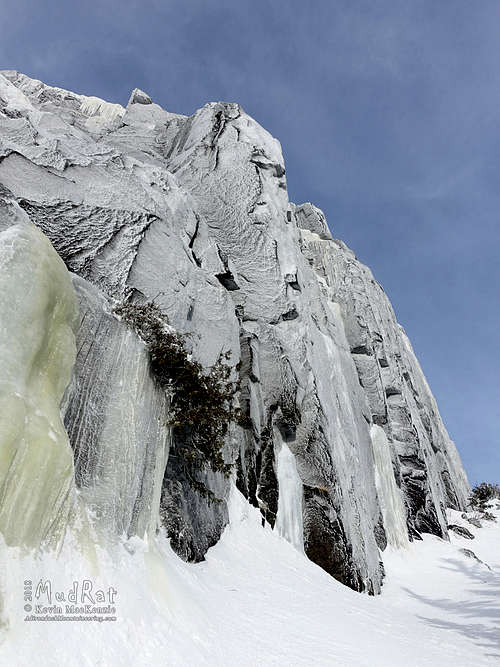
The beauty of the northern cliffs defied words when Loren and I trekked into Panther Gorge to hunt for early-season ice. We bushwhacked to the first glade at the Panther Den and emerged into a world of rime ice-covered cliffs. The strong morning sun melted some of it off—a thousand tiny ice cubes fell around us for hours.
I studied a few climbing options and decided things were too thin for my taste (I wimped out). With the pressure of climbing off my back, we lightened our load (30 lbs. metal, 460’ of rope, etc.) and bushwhacked to Haystack where we played in the talus caves and scoped the views. It was a wonderland of boulders and spruce under 5 feet of snow. I’ve never seen the cliffs completely covered in rime ice which made the 8.25 mile walk and bushwhacking worth the effort. To say this trip was a photographer’s dream come true is an understatement. It was well worth the 17 miles involved. See the photos for a taste of the experience.
Cysty Ugler (M4) and Lames Ice Hose (WI4) with Robbi Mecus - December 24, 2018
Photo Album: https://photos.app.goo.gl/WZHQMS1zouuHd1HQ9
Christmas break marked the point at which I wanted to get on some “new” routes, new to my resume of climbs at least. Fortunately, Ranger Robbi was available and had some good suggestions in mind starting with a mixed Cysty Ugler. Its aspect makes it prone to baking in the sun, so it’s a good early season climb. She offered me the lead. The bottom 80’ offered good rock gear and thin ice. By its top, I was climbing a couple fat vertical curtains.
We jumped from Cysty in Cascade Pass to Chapel Pond where Robbi took the lead on Lames Ice Hose…a usually mixed line that formed as a continuous ice line this year. It was short and fun and the ideal end to a short day of climbing.
Lillith (WI4), Rhiannon (WI4+), Patey’s Gully Direct (WI3-4) with Bill Schneider, Matt Oakes, and Ben Kurdt - December 26, 2018
Photo Album: https://photos.app.goo.gl/epB8bMTjvnnQb6Sr9
Great climbers and classic routes created a day to remember. The routes near Power Play were among my primary targets for the season. I didn’t expect to climb three so early in the game, however. They were aesthetically beautiful and comfortable to climb.
Bill led the routes for the day as I’d never been climbing in this arena and occasionally just like to follow and learn. Bill, Matt, and I shared a rope on Lillith, Rhiannon, and Patey’s. Ben Kurdt arrived later and climbed Power Play with Matt as I was on Patey’s with Bill. Power Plays central column was candled and wet—challenging—but Ben made it look like a walk in the park. I lost sight of his lead partway up Patey’s as darkness overtook the area.
This was one of my favorite days of climbing including some spice as a hundred pound chunk of ice fell as Bill climbed a roof. Ice climbing is never dull.
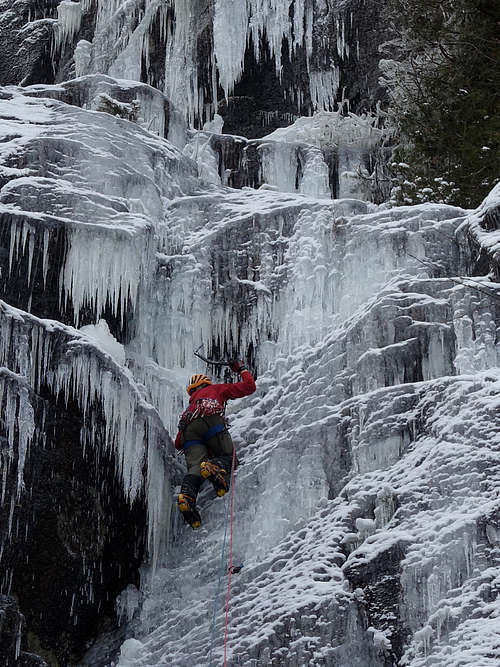
First Ascent of Apex Predator (WI4-5) in Panther Gorge - January 5, 2019
Photo Album: https://photos.app.goo.gl/sbCAbDiruuymgeAp6
Trip report also available on NEICE at https://www.neice.com/2019/01/panther-gorge-apex-predator/
I began making a list of route options in Panther Gorge during 2013. The list grew larger over the years but specific lines floated to the top based on aesthetics, length, reliability, and other factors. We crossed many off when we climbed them or as we ruled them out as undesirable options. Our target for this trip was high on my priority list and a line that remained elusive after two years of attempts. It is located deep within the Gorge near Grand Central Slide, the bottom curtain rarely touches down, and the thin layer of ice above the curtain quickly rots in the sun on the dark anorthosite rock of the cliff. Jaryn DeShane and I attempted it in February of 2018 but ended up climbing a nearby route instead since its bottom was brittle, delaminated, and thin.
January 5th, 2019
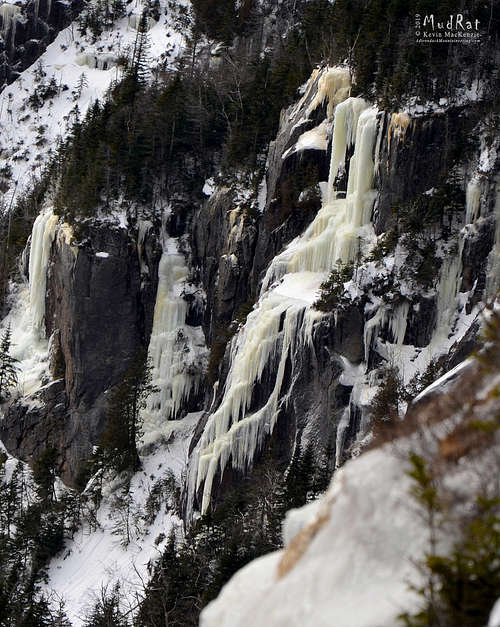
I slept through my 3:15 a.m. alarm. My friend and partner in alpine starts, Alan, spent the night on January 4th. This was a blessing in disguise. I rarely sleep through alarms, but I did this time. After calling my name several times at 3:30 a.m., he gently kicked the bed. I jumped up like my head was on fire and readied myself. We stepped out the door and were on our way to meet Aaron Courain at the Adirondak (thank Melville Dewey for this spelling of Adirondack) Loj trailhead twenty minutes later. Most of our trips begin from Keene Valley, but the deeper targets are easier to access from the Loj via the Van Hoevenberg Trail as long as I remember the off-trail navigational details.
The trail had little snow on it most of the way to Marcy Dam as our trio headed out, but the snow-pack grew as we gained elevation. Indian Falls marked the point where it was what I’d consider normal for this time of year. We walked under the light of headlamps for nearly three hours. The early morning vistas were beautiful as we approached Marcy. The mountains wore shrouds of dark blue which contrasted against the snow-covered slide tracks.
We finally arrived at the jumping-off point from the Van Hoevenberg Trail at 9:15 a.m. on the Northeast ridge of Mt. Marcy, four and a half hours after leaving the cars. The snow-pack was bulletproof, and we enjoyed clear weather with line-of-sight navigation—much different from last winter’s descent. The ridge harbors thick krummholz, so walking atop the rain crust was a blessing that saved energy compared to the usual snow-slogs. Dense growth eventually loosened as the slope steepened below us. We glissaded, walked, and tumbled down the various glades and gullies until we reached our access point at the top of the gully below the Chimney Wall, home of Marcy’s vertical trap dike. As usual, the gully had been swept by a small avalanche.
We changed into crampons and descended under fangs of wind-contorted yellow icicles and small roofs of stone. Our front-points bit into the crust and occasional ice bulges until we reached Marcy’s Great Chimney. I looked up, and the top was fat with ice. Another hundred feet of walking brought us below Panther’s Pinnacle rock climb (5.9) and an overlook of our intended quarry. I saw pillars of blue ice at the top and breathed a sigh of relief. Perhaps, I’d assessed the weather correctly. A quick down-climb led to the base of the cliff where my heart sank.
The upper and lower tiers of stone overhang, so the ice needs enough time to form. The top always builds heavily and forms hanging pillars until they touch down onto a terrace. The lower ramp/slab generally gathers some thin ice until it forms a curtain at the bottom. The warm weather (it was above freezing as we surveyed the cliff), recent rain showers, a southerly aspect, and dark sun-baked anorthosite had delaminated portions of the lower pitch. The curtain hadn’t touched down. Worse yet, I saw inches of space between the ice and stone with water running underneath. Aaron said, “It’s rotten.”
I sighed, “Yup,” and kept studying the ice.
A 20-foot section had recently snapped off and fallen down the glade. I picked up a plate of the 2-inch thick ice. It broke easily. As Aaron noted, it was rotten. There were a couple of seams where rock gear might protect the start, but it seemed likely that a crampon or tool strike in the wrong place would bring the house down on us. It wasn’t worth the risk.
I walked up the left-hand slope and spied another option. Some of the ice was delaminated, but patches looked solid enough to chance it. With luck, it would lead to the ramp. The alternate start looked fun in any case, so I opted to give it a try.
Alan belayed while Aaron took photos with his phone. It was the only camera that found its way into the backpacks, but that’s another story. I stepped onto the ice. It was better than I expected. I had to chip the rotten surface away to place screws, but the underlying ice was firm. Higher, a yellow alien protected me. I wriggled up through a chimney on a ledge and stepped in front of a huge ice bulge. A final sketchy traverse led to the wall below the pillars.
I poked around to find suitable ice for an anchor and avoided creating a belay directly below two hanging swords of ice. The recent rains had carved a channel through one of them. They’d both touch down in time. The color of the ice was a surprise. Most of it was blue, but several photos from recent years showed this area loaded with yellow ice. I scratched at the surfaces facing the sun—it was much like scratching a snow-cone. The ice in the shadows, however, was clear and solid.
Meanwhile, the sun was battering the routes to the north. Pops, cracks, and the hissing sound of ice sheets sliding on stone echoed off Mt. Haystack. Most of the noise was coming from the Agharta Wall. Such sounds do nothing to bolster confidence when one is attached to a frozen wall nine miles from the trailhead. I expected the ice on the ramp below our terrace to calve off at any moment. Thin clouds intermittently drifted over the sun and cut its warmth. I prayed that it would become more overcast.
Alan followed first, then Aaron. It didn’t take them long to reach my position. Alan and I have done plenty of leading in the Gorge, so Aaron volunteered to lead the crux. Crampons and tools easily bit into the soft ice which made the lead more of a pleasure than a battle as it would have been on the usual dry “bullet ice” of Mt. Marcy. I looked up into the “U” shaped cavity between the dripping pillars. They looked like angel wings. Most of the ice looked appealing, but some appeared whitish and aerated. It wasn’t long before Aaron was stemming up the last steep run. He yelled, “Turf!” when he reached the top and buried a tool in frozen soil. A loud hoot sounded quickly after. His enthusiasm was contagious.

Alan climbed next, casting small bits of ice down around me as he kicked into the wall. His departure left me to take photographs and enjoy the peaceful setting. Distant voices on Haystack’s summit sounded close without wind sweeping through the Gorge.
The route was much as I expected once I started climbing, though the vertical sections were longer than they looked from below—typical foreshortening. It only took a swing or two to find a good axe placement as opposed to the multiple strikes it took to procure a safe stick while leading Spiritus Draconis last year. I love this type of ice—a rare treat up this high. The cavity between the pillars seemed to swallow me as I stepped into it and looked up the final wall. The thought struck me that I was nearing the completion of a two-year-old dream. I was consumed by the peace of the moment and appreciated each second of the climb.
My smiling companions greeted me at the top. They were standing on a few feet of snow, attached to a large balsam. I felt a surge of accomplishment and a little relief that the long approach trip had worked out. The sting of previous failed attempts faded and made the climb that much more meaningful. Alan asked if I had a name in mind. Climber Nolan Huther had suggested Apex Predator. It seemed fitting given the feline theme we often try to pull from.
We took a moment for a quick walk south to the top of a knoll. The scenery beyond displayed Marcy’s East Face and several ice lines on its vertical north side. In the obvious gully below, but out of sight, was Grand Central Slide.
We rappelled the length of the route from a stout tree set 20 feet back from the cliff top. I slowed down after the terrace and gingerly stepped down the low-angle ice above the initial curtain. I wanted to inspect it. As expected, the sheet was hollow, and I saw fracture lines about 40 feet above the ground. We were wise to avoid poking this particular dragon.
We ate lunch in the glade below the cliff, standing amidst a yard sale of gear. Spiritus Draconis beckoned from the south. We discussed climbing the nearby route. Alan needed a lead, and the route needed a second ascent. Aaron was satisfied with what we’d already accomplished. He relaxed and enjoyed the serenity of Panther Gorge and the majestic views while Alan and I climbed.
The route was thinner than when Jaryn DeShane and I put it up…and softer. Ice always looks less steep from afar. Alan angled toward the left side of the flow and said, “It looks a lot steeper from here.”
I retorted, “That’s because you’re below the sustained vertical section—a good 50-foot wall. There are rests on the right side.”
He picked a line in between the two and, after about 20 minutes, disappeared onto the lower-angled top section and into the woods. I followed as quickly as I could to save time and topped out a few minutes later. We were done by 3:50 p.m. It took less than an hour for this route, especially without the route-finding details.
There wasn’t time for another. We wanted to make this an “early” day. Besides, I hoped to reach the trail by dark. We trekked back up to the Chimney Wall’s gully and made the thigh-burning ascent back up to the “rabbit hole.” I looked at the Great Chimney and noted an adjacent line to its north. I hadn’t noticed it in the past—one more for the list.
Navigating out of the Gorge was easy if not grueling. The packs felt heavy. Perhaps we were simply wearing down. Multiple breaks to take photos of the glowing crown of Haystack and multi-colored sunset allowed me to catch my breath. The slope eased after 45 minutes which signaled that we would soon enter the grip of the krummholz again. A yell from Alan brought us to a halt. He’d fallen into a spruce trap and was searching the hole for his snowshoe. Meanwhile, the weather changed, and clouds rolled in from the northwest. I watched the summit of Marcy disappear in a gray cloud as the wind increased.
Ten minutes later, Alan still couldn’t find the shoe and gave up with the intent of returning during the summer to continue the search. I thought, That should be a hoot…
Trekking back to the Loj was a matter of putting one foot in front of the other. I was still feeling the inner peace that such a day always elicits. The headlamps lit the fog as I mentally ticked away the benchmarks—Indian Falls, the Phelps summit trail, Marcy Dam, etc. We’d started at 4:45 a.m., and it was only 8:15 p.m. when we reached the trailhead again. A day that’s under 15 ½ hours is below my average. That, in my book, is a good outing and getting on the new line was a prayer answered.
Working at Mountainfest with Don Mellor - January 19-20, 2019
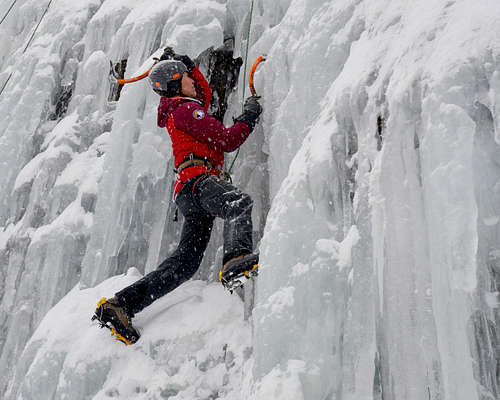
Photo Album: https://photos.app.goo.gl/NYpZE5Gj7yzsNhXL6
Mountainfest was in full swing as January neared its end…as was a blast of cold air and winter storm. Don contacted me several weeks prior and asked if I’d be his assistant for the weekend while he taught the art vertical ice climbing at Pitchoff’s Quarry. What can I say? It doesn’t get any better than spending the weekend with a friend and master of steep ice! There were about 18 students spread over two days including Katie Vannicola who I’d guided back in October on Whiteface Mountain’s Ski Slides.
Lillith with Dan Plumley - January 26, 2019
Photo Album: https://photos.app.goo.gl/gkLaAfkYNSSNDd456
Just another great day out with a friend. The ice was fatter than my December climb with Bill Schneider which made it a fun lead with great gear. While the underlying rock of an ice climb is always the same, the ice may be completely different from day to day. Such was the case as the photos show. Magnificent candles, forming pillars, and delicate curtains adorned the route.
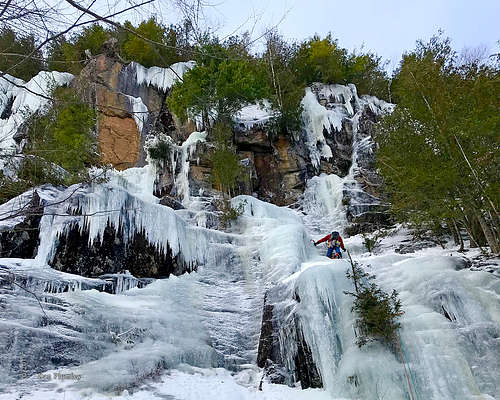
Power Play (WI4-5) and Rhiannon with Devin Farkas - February 2, 2019
Photo Album: https://photos.app.goo.gl/NLm3kqMSG6Ns4bcU7
I’d been focusing on other climbs and the backcountry for many years. Power Play was a priority this winter, so when Devin wanted to give it a whirl, I was excited. I led the first pitch via the ramp which kept it around WI4 and Devin took the upper pitch. We then switched over to Rhiannon. Again, conditions were much fatter than in December as one would expect.
One of the pleasures of climbing with other dramatic routes nearby is the opportunity to capture dramatic photos of others. Climbers on Rhiannon made excellent subjects from our perch atop Power Play. Chapel Pond far below offered a wintery backdrop.
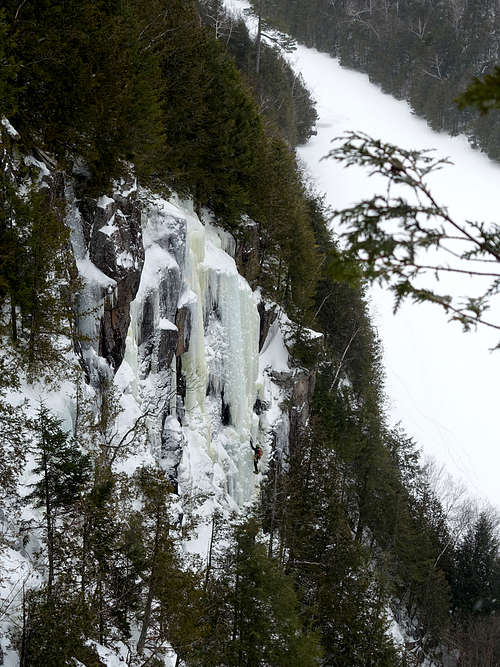
Avalanche Mountain Gully (WI4-) - February 9, 2019
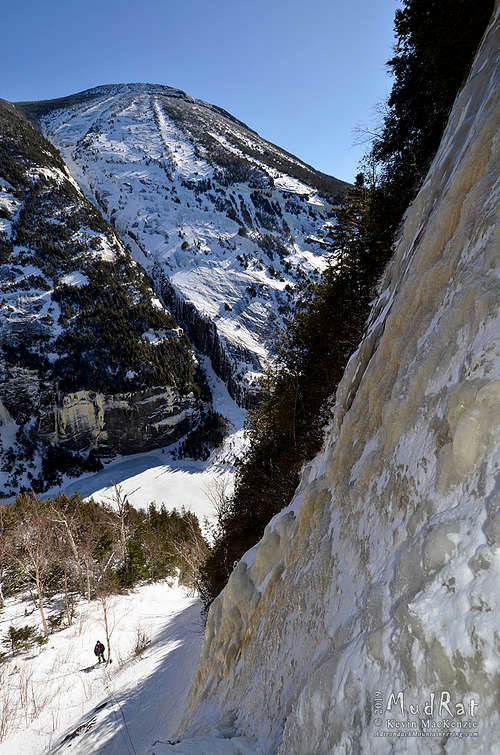
Photo Album: https://photos.app.goo.gl/z5KbPzvwajeNGYAx8
Look for a story on this in Adirondack Explorer during winter of 2019.
The beauty that Christ manifests in nature is astounding. I've always said that walking out into the wilderness is like walking with Him.
This trip reflected it once again as Phil Brown (formerly of ADK Explorer newsmagazine) and I trekked into Avalanche Pass and climbed the magnificent gully across from the Trap Dike. The climb is accessed up the slope from the hitchup-matilda across from the Trap Dike. A climb of a few hundred feet up a semi-firm glad of neve led to a short ice step and the base of the climb.
Phil looked at me and said, "Well, what do you think?" -- it was steeper and perhaps bigger than he envisioned. I said, "Looks great!" and proceeded to the base. The yellow ice was aerated and screw placements weren't always easy since there was still some runoff from the recent melt. Several of the tubes flash-froze. Some stout climbing led to a small terrace below a hole aka "the cave." Some people head left around the curtain of fragile daggers, but I went into the cave and found a few sketchy sticks that led to a wet pillar/curtain. Another ledge led to the belay tree at its top.
The views of other ice climbs--the Matrix, Goldrush of '96, the Trap Dike--were stunning. Cold temperatures (around 0 Fahrenheit) also helped...there was no humidity and not a cloud to be found. Shadows played in stark contrast to the sunlit snow and made catching memorable photos quite easy.
In hindsight, I realized that I’d lost my patience during the climb. I could feel my wick wasn’t as long as usual and I noted it as odd. The trip also seemed more tiring than I anticipated. It turns out that I had the flu! The doctor verified influenza a couple days later. There’s always an unanticipated trial of one sort or another in the backcountry.
Chouinard’s Gully (WI3) Moonlight Photo Session - February 16, 2019
Photo Album: https://photos.app.goo.gl/6ALsHMRxryAPGnZ16
This was a last minute surprise. Long-time Keene guides R.L. and Karen Stoltz were working on another project…night ice climbing photography so Steve Thomas, ADK climbing pioneer Tom Dubois, and I climbed the multi-pitch gully under moonlight and illuminating each other with headlamps at R.L.’s direction via 2-way radios.
The gully was a fun climb during the day, but night time shadows and the color of ice under the glow of headlamps made it unforgettable. I led the first pitch and Steve, a climber from South Africa, burned up the final hundred or so feet. I definitely acquired an appreciation for night climbing as a result of this venture.
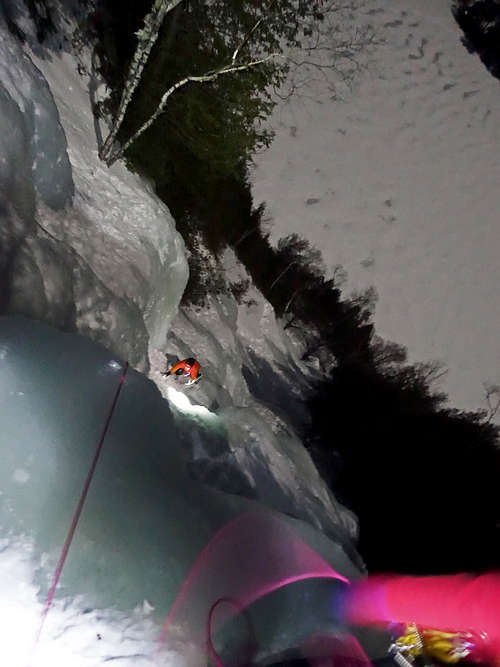
Cascade Ice Dance (WI4), 3 Flows (WI4) with Devin Farkas and Kennedy Quigg - February 22, 2019
Photo Album: https://photos.app.goo.gl/jsxRnM2aSp8fUdtz5
Devin Farkas (lead), Kennedy Quigg, and I climbed Cascade Ice Dance and Three Flows in Cascade Pass. The ice was variable with delaminated, fragile, and finally reliable ice at the top.
I was still feeling a bit weak from the flu. My “lead head” was nowhere to be found, so I asked Devin to lead which was just a pleasure to behold from below. The start was less than sure as the ice didn’t touch down so a bit of dry tooling and delicate work on moderately laminated ice was involved in ascending to the “real” ice. The grade eased off on a ramp below a roof where the ice was again discontinuous. Devin protected the roof from below with a few nuts in a bomber crack (his only option), sunk an axe into the ice above the roof, took a breath, and committed everything to the move. A single crampon front point pivoting on a small edge was the only foot placement that aided the maneuver. It was fun to follow, but a heady lead.
Above the roof, the real ice came into play with a couple vertical curtains. We staged the ascent, so that I followed half the climb, then Kennedy followed me. Rinse and repeat for the final section. I suggested that for photographic purposes, but forgot the camera below (yup, I was off my game altogether).
We rappelled and walked over to Three Flows. Devin led again where we top roped. I originally declined to climb at all, but got my second wind and followed it by using a single ice tool instead of two since we were top roping. Kennedy burned it up and our day ended with the satisfaction that we’d climbed one of the Adirondack’s most aesthetic roadside lines.

Power Play (central column - around WI4+) / Mineville Pillar (WI4) night shoot Ken Hebb, and Steve Thomas - March 2, 201
Photo Album: https://photos.app.goo.gl/9hbMgUvJgXBboeyR9
Power Play was still on my mind in March, but I wanted to lead the central pillar instead of the ramp. It’s a steeper and much more intimidating in your face climb. I was having a good season, so the timing seemed ideal. Steve Thomas and Ken Hebb were with me on what started as a blue-bird day in warm temperatures. Steve took the second pitch which had entirely different features than a month earlier—an ice chimney was a nice surprise!
I was thrilled that my father, Mac MacKenzie, ventured down to “the pond” to shoot some photos of us climbing Power Play. It’s rare that I get decent shots of me leading from afar.
We’d also agreed to do work with the Stoltz' on their Up in the Dark photo project later in the evening at Mineville Pillar, so this got our blood flowing. The Stoltz’ prefer to photograph climbers on routes that they have never led to capture the emotions as they figure out the climb. I fit into the scheme perfectly in this respect. The pillar was about 120’ tall and steep. They had me lead once during daylight and another after darkness (and a light snowstorm) settled in. Steve led a third time. Each of us took a turn manning a secondary flash mounted on a pole for lighting from below. R.L. photographed from the side while Karen shot from the top of the pillar. The day ended with laughs and a wonderful batch of homemade brownies thanks to Karen.

The Matrix (WI5+), Warm Up (WI4), Adirondike (WI3+) with Devin Farkas and Marielle Matthews - March 9, 2019
hoto Album: https://photos.app.goo.gl/rRZVz5NYvzS9mhmSA
Video: https://www.youtube.com/watch?v=NMrFHNIMKYs
Route Description: https://www.mountainproject.com/route/112408270/the-matrix
March 9th was a climbing dream come true—perfect weather with a bluebird sky, good company, and three climbs in Avalanche Pass. The Matix is a dream-line of hard climbing, a notch above anything I’d touched in the past.
Devin Farkas and his wife Marielle made the day complete. We met at Adirondak Loj at 6:00 a.m. with a climb up the relatively “fat” Matrix in mind. I saw it was in good condition during the Avalanche Mountain Gully climb and hoped to get on it this season. Our timing was good considering an impending warm up.
We shared the trail with friend and guide Colin Loher who was leading a client up the Trap Dike which made the 5-mile walk pass by quickly. Devin hopped on the Matrix at 9:00 and topped out an hour later. I then Marielle followed. I’d describe the route as hard, heady, and incredibly interesting. I’ve never climbed its equal. Hard moves, short sections of overhanging ice, odd body positions, and brittle ice made it a climb to remember. The position of the climb over the lake was breathtaking.
A steady stream of hikers, skiers, and climbers on Adirondike and Avalanche Mountain Gully almost made it feel almost roadside. The warm sun took any issues of cold hands out of the equation.
I led the following two climbs, Warm Up and Adirondike. Warm Up was a plumb line up tannin-stained ice in a corner on the left side of the cliff. Adirondike saw three parties including us. I started leading that around 3:30 p.m.—following on the heels of another set of climbers. The setting sun lit our climb until it was blocked by the overhang at the top.
With the trio of climbs behind us we exited the pass with the sliver of a rising moon behind us and arrived at the trailhead about 14 hours after starting. Thank God for another safe, exciting day in the backcountry. Thank God for another dream to reflect on as a lead for next year…
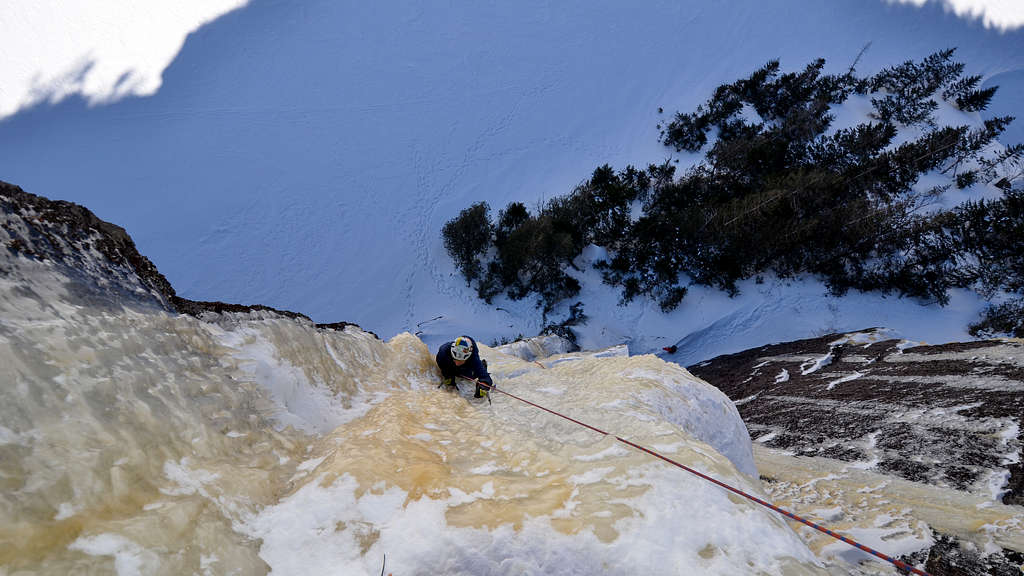

Guiding Colden’s Trap Dike with Katie Vannicola - March 16, 2019
Photo Album: https://photos.app.goo.gl/G2aUJbKuyNZWqGex6
Video: https://www.youtube.com/watch?v=xxuDDYrJZ0U&t=10s
Fun times guiding the Trap Dike! Strong winds with wind chills near zero were the theme for the Trap Dike this trip. Warm weather loosed a flow of water in the Dike, but not at a high volume (like my climb with Jaryn DeShane a few years ago). The crux was only about 15' tall since the neve was nearly 20' deep as we approached. The ice was reforming as we climbed—imagine climbing a slushy with moderately firm ice a few inches under the surface. The Trap Dike Slide held a little bit of powder, but neve and some short runs of ice covered most of the slide. We couldn't have found better conditions.
We ate lunch before getting on the slide and enjoyed various views of a curtain of ice that was decimated by the warm weather and reformed into delicate columns. Photos in the album above include columns that were sculpted by strong westerly winds which made it refreeze in a hood of sorts. The yellows are from tannin. Other photos show a fragile column that was barely connected. An occasional resounding POP from thermal contraction--when warm temperatures suddenly turn colder and the ice contracts and cracks-made us jump on occasion.
Conditions this time were incredibly different from December when I’d also guide the Dike with a gentleman named Oleg. It was like climbing a 2,000’ crystal chandelier with little snow—conditions that made it more technical in snowy conditions.
A Foggy Bushwhack in Panther Gorge with Loren Swears - April 6, 2019
Rather than rewrite the trip report, I’ll include the following link with photographs and a narrative: https://www.summitpost.org/a-foggy-april-bushwhack-in-panther-gorge/1032625 . Suffice it to say that I simply couldn’t let the season pass without taking another trip into the Gorge in hopes of hopping on another project. We ran into some interesting conditions including a 10-foot snowpack, bushwhacking in nearly zero visibility from Marcy’s ridge, sketchy ice, and three people trying to climb Marcy with “I’ll need a rescue soon” type gear.

For All Things, an End
All good things must come to an end, but that just means the birth of another season. The ice held on into a rainy late April. In retrospect, the ice climbing season was more than I could have hoped for. I usually set goals expecting not to reach some of them. It’s incredible when everything falls into place.
In closing, I’ve always drawn inspiration from both the mountains and scripture. They are tied in my mind and the ability to recreate in the wilderness is a blessing for which I always give thanks. The thought brings a verse to mind. Psalm 121:1-21-- I lift up my eyes to the mountains— where does my help come from? My help comes from the Lord, the Maker of heaven and earth.
Thanks be to God for a safe, wonderful season with good friends and nearly perfect ice-building conditions.

